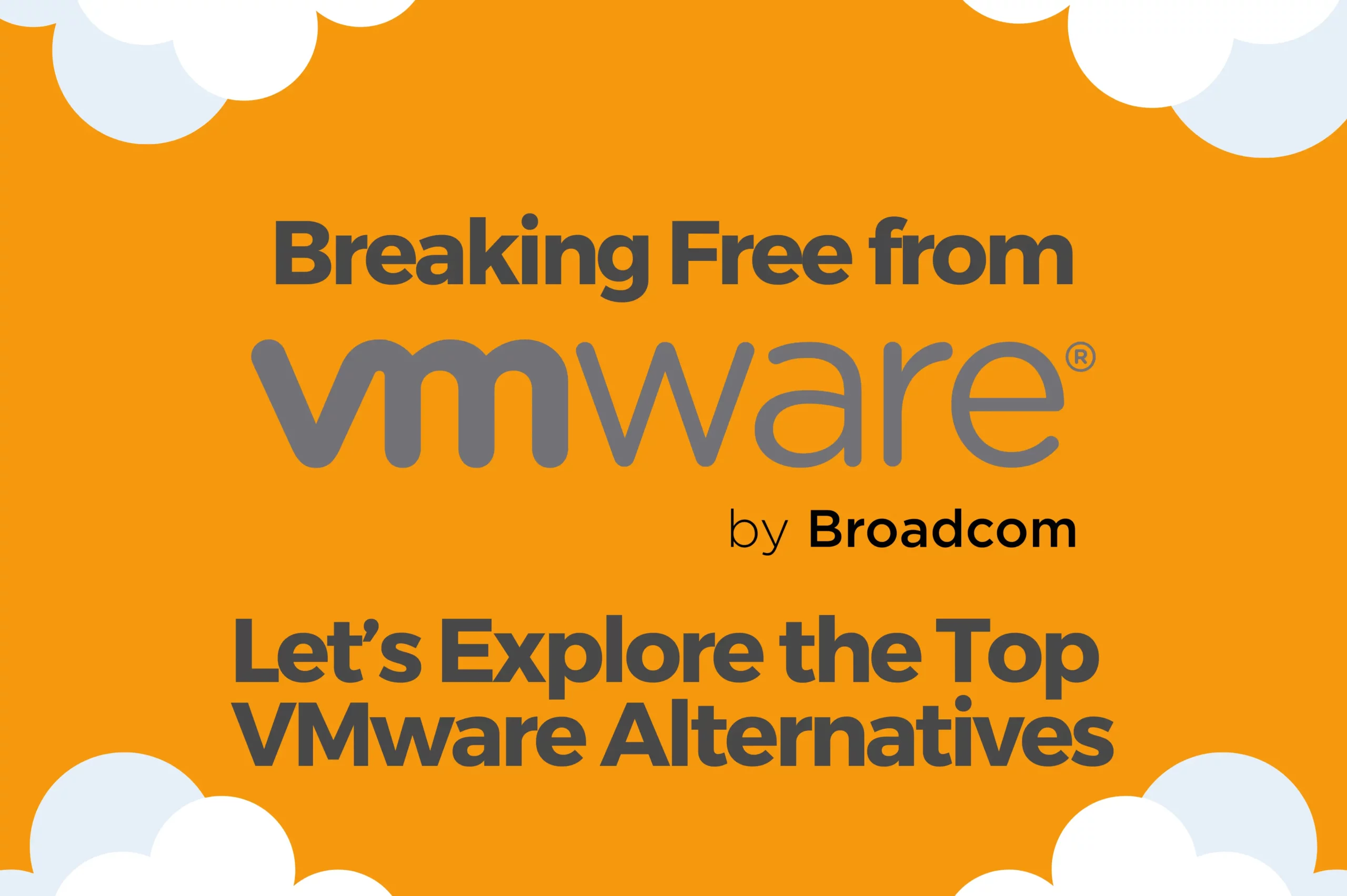Breaking Free: Exploring Top VMware Alternatives
In light of the recent licensing changes and Broadcom’s acquisition of VMware, affected customers are increasingly seeking alternatives. The transition from perpetual licenses to subscription models has significantly impacted customers, introducing ongoing costs and reducing flexibility in licensing arrangements (read more about it in our last post).
This change has left thousands of customers frustrated and constrained, as they are now locked into recurring payments without the option to maintain their previous perpetual licenses. Furthermore, Broadcom’s acquisition of VMware has raised concerns about the direction and priorities of the company under new ownership, leading customers to question the future of VMware’s product offerings and support.
As a result, customers are exploring alternative virtualization and cloud computing solutions that offer more favorable pricing structures, greater flexibility, and more transparency for future development. Open source tools are a great option in order to avoid vendor lock-in and proprietary licensing constraints.
In this blog post, we’ll dive into some of the top alternatives to VMware, including Kubernetes, OpenStack, Proxmox, and Apache CloudStack, highlighting their key features, benefits, and use cases.


What are alternatives to VMware?


Kubernetes (K8s) + KubeVirt
As you might have heard, Kubernetes is the platform for deploying and managing cloud-native applications. It is a container orchestration system that allows developers and admins to define the desired state of an application, and the platform will automatically handle the deployment and scaling of the application. Virtual Machines, on the other hand, are designed to run not only containers but entire operating systems and applications.
Kubernetes is commonly used on top of VMware and cloud platforms to manage containerized applications, since it is not capable of running VMs natively. However, running VMs on K8s became possible with the appearance of projects such as KubeVirt, which uses libvirt with KVM hypervisor under the hood to spawn and manage VMs. This means that by default, out of the box, Kubernetes cannot be a direct replacement for VMware. However, Kubernetes has a very rich ecosystem being a part of the Cloud Native Computing Foundation (CNCF) where tens of open source projects can be leveraged to extend Kubernetes functionality.
Some of these projects include Rook and OpenEBS for storage and Cilium for networking. Rook can be used to deploy and manage Ceph on K8s easily. It turns the well-known distributed storage solution into self-managing, self-scaling, self-healing service delivered with Kubernetes. OpenEBS is another cloud native storage solution that provides containers with easy access to storage across the entire K8s cluster. Cilium provides networking, security, and observability for cloud native environments such as Kubernetes through a CNI plugin. As of now CNCF hosts more than a hundred open source tools and projects with at least a half being focused on Kubernetes, making it possible to tweak, extend and apply Kubernetes for a wide range of applications and scenarios.

Openstack
Both VMware and OpenStack can be used to host traditional and cloud-native workloads offering management via a self-service portal. And both platforms leverage virtualization and containerization technologies to provide infrastructure management and deployment.
You can find most of VMware’s infrastructure components and features in OpenStack itself and its underlying technologies for compute, network and storage virtualisation. This includes Kernel-based Virtual Machine (KVM), Open Virtual Network (OVN) and Ceph, putting Openstack among the best alternatives to VMware, since it is capable of replacing most of VMware functionalities.
The adoption of OpenStack has been steadily growing since its first release in 2010. Companies like Openstack for its flexibility and its solid ability to support bare-metal, container technologies, and VMs at the same time. Furthermore, it is open source and vendor-agnostic and runs under an Apache Licence, which will shield you against vendor lock-in or unpredicted licensing costs.
While some of the Openstack subprojects might have lost their traction it still has a very strong core set of services and a broad community of contributors and supporters. There are also quite a few companies that integrate Openstack and offer paid support. Companies that use Openstack today include Wikipedia, Ericsson, Intel, Yahoo, Huawei and hundreds of others.

Proxmox Virtual Environment (Proxmox VE)
Proxmox VE is an open-source virtualization platform that combines KVM virtualization, LXC containers, and software-defined storage and networking. It is a great alternative for small-scale clusters.
Proxmox offers a web-based management interface and supports features such as live migration, high availability, and backup/restore. It offers integrated Ceph and backup solutions out-of-the-box, requiring no license to begin.
Proxmox includes all features by default, and can be used to build and monitor VMs with LXC and KVM instances. It can also be used to monitor the storage with software-defined storage.
Proxmox is another open-source software that helps to avoid vendor lock-in. Although Proxmox might not be the best fit for large-scale enterprise environments, its vibrant community and reliability make it great to be for small scale environments.
Apache CloudStack
Apache CloudStack is another open-source cloud computing platform that provides Infrastructure-as-a-Service (IaaS) solutions. It can be a compelling alternative to VMware for virtualization and cloud management for organizations seeking a flexible and open-source cloud computing platform.
While Cloudstack seems to be similar to Openstack in many ways, it has never reached the popularity of the latter. Nevertheless, it is capable of managing VMware vSphere infrastructure along with other hypervisors such as KVM. This feature might come in handy for migrating from VMware ESXi to KVM.
Like Openstack, Apache Cloudstack offers multi-tenancy, self-service provisioning, and integration with third-party vendors and technologies.

C12n Private Cloud Solution
If you are looking for a modern, vendor-neutral alternative to VMware that’s enterprise-ready out of the box, look no further than c12n.
At Cloudification, we’ve combined our open source expertise and developed a solution called c12n – a private cloud platform based on OpenStack, Kubernetes and Ceph. It’s designed for organizations looking for a reliable and future-proof alternative to VMware, with full control over their infrastructure and no dependency on proprietary vendors.
With c12n, we’ve distilled years of experience into a pre-integrated platform that covers essential IaaS/PaaS use cases, including virtual machines, containers, software-defined networking, storage and more.
With c12n, you get:
- A full IaaS solution, suitable to run VMs, containers and Kubernetes clusters
- Multi-tenancy and strong network isolation
- Integrated monitoring and alerting
- Optimized Ceph-based storage
- Expert support from the open-source and cloud-native specialists at Cloudification
c12n empowers businesses to escape from Broadcom’s aggressive subscription model by giving them full control over their infrastructure – without the complexity of building and tuning OpenStack on their own.
Conclusion
As more organizations look to move away from VMware, open-source alternatives like Kubernetes, Proxmox, Apache CloudStack, and especially OpenStack are gaining momentum. They offer compelling features, such as strong ecosystems, flexibility, and cost transparency – qualities that are increasingly valued in light of Broadcom’s changes to VMware’s licensing and product roadmap.
OpenStack stands out as the most comparable replacement to VMware in terms of features, scalability, and maturity. It’s supported by a global community and a growing number of professional services and platforms.
Whether you are planning a migration or just starting to evaluate your options, OpenStack and platforms like c12n offer a clear path forward, without vendor lock-in and without sacrificing enterprise-grade capabilities. Reach out to us today and learn how Cloudification can power your infrastructure transformation.

